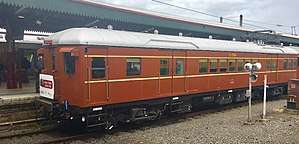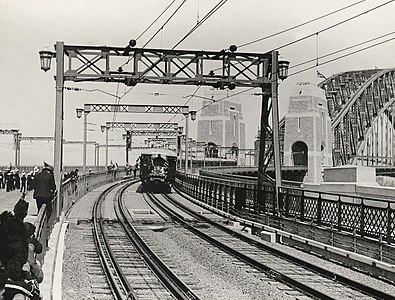New South Wales Standard suburban carriage stock
The New South Wales Standard suburban carriage stock are a type of electric multiple unit that was operated by the New South Wales Government Railways and its successors between 1926 and 1992. They served on the Sydney suburban network. In the years before their withdrawal, they were nicknamed Red Rattlers.
| New South Wales Standard suburban carriage stock | |
|---|---|
 Power car C7396 on set F1 at Central station | |
| In service | 1925-1992 |
| Manufacturer | |
| Built at | |
| Constructed | 1925-1937 |
| Number built |
|
| Formation | 2-8 carriages |
| Fleet numbers |
|
| Operator(s) | |
| Depot(s) | |
| Line(s) served | All Sydney suburban except Eastern Suburbs |
| Specifications | |
| Car length | 18.75 metres (61 ft 6 1⁄4 in) |
| Width | 3.15 metres (10 ft 4 in) |
| Height | 3.92 metres (12 ft 10 3⁄8 in) |
| Doors | 4 |
| Maximum speed | 80 km/h (50 mph) (TfNSW limit) 20 km/h (12 mph) through platforms |
| Traction system | 2 x Metropolitan-Vickers 172s per carriage |
| Electric system(s) | 1,500 V DC catenary |
| Current collection method | Single-pan diamond pantograph |
| Braking system(s) | Westinghouse |
| Track gauge | 1,435 mm (4 ft 8 1⁄2 in) standard gauge |

History
To provide rolling stock for the electrification of Sydney's suburban rail network, steel carriages were ordered.[1][2]
The initial 50 power cars were built in England by Leeds Forge Company and shipped to Australia in knocked-down condition. They were assembled by Eveleigh Carriage Workshops (10) and Clyde Engineering (40) between April and October 1925. Initially numbered 2213-2262, they entered service being inserted into sets with Bradfield carriages for haulage by steam locomotives until fitted with Metropolitan-Vickers electrical equipment and motors in 1926. At this stage they were renumbered C3101 to C3150.[1][2][3]
Between 1926 and 1929, a further 290 power cars, 248 trailer cars and three parcel vans were built in Australia by Clyde Engineering and Walsh Island Dockyard.[4] In 1937, Clyde Engineering built a further 12 power cars, to provide coverage while the 1920s built power cars were overhauled.[5] The reason for the imbalance between motor and trailer cars was the conversion of some American Suburban carriage stock to operate with the new power cars.[1][2]
| Numbers | Builder | Years Built | Total | Notes |
|---|---|---|---|---|
| C3101-C3150 | Leeds Forge Company | 1925 | 50 | Initially entered service as locomotive hauled carriages 2213-2262 |
| C3151-C3170 | Clyde Engineering | 1926-27 | 20 | |
| C3171-C3220 | Walsh Island Dockyard | 1926-27 | 50 | |
| C3221-C3250 | Clyde Engineering | 1926 | 30 | |
| C3251-C3300 | Walsh Island Dockyard | 1928 | 50 | |
| C3301-C3440 | Clyde Engineering | 1928-29 | 140 | |
| C3441-C3452 | Clyde Engineering | 1937 | 12 | |
| C3901-C3903 | Clyde Engineering | 1928 | 3 | Parcel vans |
| T4301-T4548 | Walsh Island Dockyard | 1927-29 | 248 | T4543-T4548 rebuilt as driving trailers D4051-D4056 in 1937 |
In 1937, six trailers (T4543-T4548) were converted to driving trailers.[2] Between 1968 and 1975, some power cars were fitted with two motor air suspended bogies. These were renumbered upwards by 4000, e.g. C3306 became C7306.[6]
Colour Schemes and Overhauls
As built, the standard cars were painted in Tuscan red and russet with yellow pin striping.[7] In the 1940s, that was changed to Tuscan red with buff lining.[7] In 1957, the livery was changed to plain Tuscan red, which many cars retained until their withdrawal.[7] From 1973, the livery became Public Transport Commission blue and white, before that was superseded by Indian red in 1976. The original cream and brown interiors were repainted in two-tone green, but that was not done to all cars. Overhauls of the stock continued up until 1988, with some receiving sliding aluminium Beclawat windows to alleviate rust problems.[3][5][6] A few cars also received Airmate pantographs, replacing the original Dorman Long pantographs.[7]
Withdrawal
Withdrawals commenced in the 1970s, 92 remained in service with CityRail in July 1991.[6] The last were withdrawn in 1992. Several have been preserved.[3][8][9][10][11][12]
Preservation
Set F1, which is made up of four carriages (C7396, C3218, T4527, C3426), is preserved and in operational condition. This is as a result of collaboration between Sydney Trains, Transport Heritage NSW, who plan public trips and tours on the train, and Historic Electric Traction. The restored train resumed carrying passengers on June 11, 2016, 14 years since its last such trip.[13][14] One of the carriages of set F1, power car C3426, led the first electric train to cross the Sydney Harbour Bridge. All four cars were built in 1927.[15]
Transport Heritage NSW / Sydney Trains has multiple Standard cars in the care of Historic Electric Traction[16]
C3102 - Leeds Forge (2 motor) Power Car - Stored at Redfern Carriageworks
C3218 - Walsh Island (2 motor) Power Car - Operational at Flemington Car Sheds
C3426 - Clyde Engineering (2 motor) Power Car - Operational at Flemington Car Sheds
C3653 - Walsh Island (2 motor) Parcel Van (ex C3903, C3553, C3773) - Stored at Redfern Carriageworks
C7396 - Clyde Engineering (4 motor) Power Car (ex C3396) - Operational at Flemington Car Sheds
D4052 - Walsh Island Driving Trailer Car (ex T4547, D4673) - Stored at Redfern Carriageworks
T4527 - Walsh Island Trailer Car - Operational at Flemington Car Sheds
Transport Heritage NSW / Sydney Trains also has a Standard trailer car in the care of the NSW Rail Museum, Thirlmere.
T4310 - Walsh Island Trailer Car - Static Display at NSW Rail Museum, Thirlmere
The Sydney Electric Train Society has six Standard cars. The five motor cars were obtained in 2008 from Railcorp Office of Rail Heritage (now Transport Heritage NSW) during a disposal of non-core heritage rolling stock items in the collection.[17]
C3104 - Leeds Forge (2 motor) Power Car - Stored at Bilpin
C3237 - Clyde Engineering (2 motor) Power Car - Stored at Chullora
C3444 - Clyde Engineering (2 motor) Power Car - Stored at Bilpin
C3650 - Clyde Engineering (2 motor) Power Car (ex C3399. Converted & modified to electric car sheds Shunter) - Stored at Chullora
C3660 - Clyde Engineering (2 motor) Power Car (ex C3318. Converted & modified to Parcel Van, then ELCAR Shunter) - Stored at Chullora
T4408 - Walsh Island Trailer Car - Stored at Cranebrook
Due to their width, Transport for NSW limits the speed of these carriages to 80 km/h during normal running and 20 km/h when passing platforms. They are further limited to running in wide gauge track areas only, which includes the whole suburban network, but does not include the Main North or West lines leaving Sydney.
References
- Churchman, Geoffrey (1995). Railway Electrification in Australia & New Zealand. Smithfield: IPL Books. pp. 85, 92.
- "Sydney's Electric Trains from 1926 to 1960" ARHS Bulletin issue 761 March 2001 pages 90-93
- C3104 - 1925 Leeds Forge Standard Motor Car Sydney Electric Traction Society
- History: The old Red Rattlers live on Newcastle Herald 12 September 2014
- C3444 - 1937 Clyde Modified Motor Car Sydney Electric Traction Society
- "Rolling Stock" Railway Digest December 1991 page 454
- Sydney's Suburban Standards - The Leeds Forge Cars C3101 - 3150. Roy Howarth, Glenn Ryan. 2010. pp. Pages 16–21, 70, 76, 77.
- C3102 - Leeds 1927 Suburban Motor Car NSW Environment & Heritage
- C3218 - Walsh Island 1927 Suburban Motor Car NSW Environment & Heritage
- C3653 - Walsh Island 1927 Suburban Parcels Van NSW Environment & Heritage
- D4052 - Walsh Island 1927 Suburban Trailer Car NSW Environment & Heritage
- T4527 - Walsh Island 1927 Suburban Trailer Car NSW Environment & Heritage
- "The Red Set F1 Project – Sydney's Vintage Electric Train". www.schoolpa.com.au. Retrieved 8 January 2018.
- "Sydney Heritage Red Rattler to run after 14 years". Railpage. Retrieved 8 January 2018.
- "NSW Rail Museum". NSW Rail Museum. Retrieved 8 January 2018.
- "Heritage Fleet". www.het.org.au. Retrieved 8 January 2018.
- 2003, Matthew Doyle. "SETS Fleet - Single-Deck Suburban Cars". www.sets.org.au. Retrieved 8 January 2018.CS1 maint: numeric names: authors list (link)